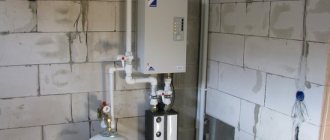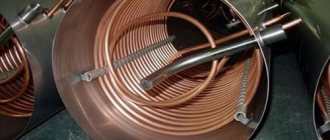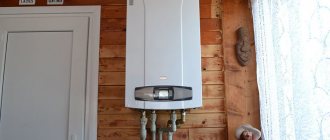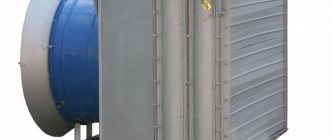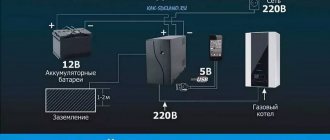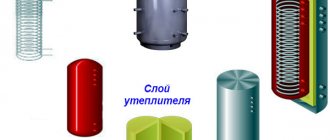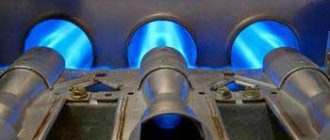When choosing a solid fuel boiler, you need to consider power. It determines whether the device can create the required amount of heat for the entire house or not. It is undesirable to choose a boiler that is too powerful, because it will operate in economy mode, and this will affect the reduction in efficiency.
To make the right choice of a solid fuel boiler, you need to know two indicators:
- The amount of heat required to heat the room and heat the water.
- The real power of the device.
Calculation of power depending on the volume of the room
The calculation formula is:
Q = VxΔTxK/850,
- where Q is the amount of heat , defined in kW/h4;
- V – volume of the room (unit of measurement cubic m);
- ΔT is the difference between the outside temperature and the indoor temperature;
- K – correction factor taking into account heat loss;
- the figure 850 is used to convert the product of the above three indicators into kW/hour .
K can have the following meanings:
- 3-4 – for premises that are a simplified wooden structure or a building made of corrugated sheets.
- 2-2,9 – for buildings with little thermal insulation. The design of such houses is simplified, the wall thickness is equal to the length of 1 brick, the windows and roof have a simple structure.
- 1-1,9 – for houses whose design is standard. The brickwork is double, the number of simple windows is small. The roof has a conventional roof.
- 0,6-0,9 – for houses with improved construction, double thermal insulation of brick walls, double glazed windows, thick floor base, roof made of good thermal insulation material.
As an example, let's take a modern house with an area of 200 square meters. m, wall height 3 m and first-class thermal insulation. The house is located in an area where in winter the temperature does not drop below -25 °C. In this case, ΔT = 20 – (-25) = 45 °C. Therefore, to heat a house you need to create Q = 200*3*45*0.9/850 = 28.58 kW/h. The figure should not be rounded, because it is not final and you need to increase it with your own hands by the amount of heat for the hot water supply. If the water is planned to be heated in a different way, then the result obtained is not adjusted, and part of the calculation is completed.
Objective parameters for power calculation
To calculate how powerful the equipment should be, it is necessary to take into account a lot of parameters. Almost all of them have a mathematical expression and participate in a formula that gives accurate indicators of the power of solid fuel boilers.
Parameters that need to be taken into account include:
- Room volume
(V cubic m). Surely you know the area of your home and the height of the ceilings. - The difference in t °C
between the desired indoor and expected outdoor temperatures in the coldest period and (ΔT °C). Calculated individually based on your preferences and the climate of the region:
- if you want 22 °C in the house - (- 28 February degrees) = 50 °C. It is this indicator that will need to be substituted into the basic calculation formula, which we will present below.
- Heat coefficient
that is lost for various reasons (K). Generally accepted values determined experimentally. Choose from the following list the one that suits your home: - 3-4 – wooden country house without additional insulation (brick or polystyrene foam);
- 2-2.9 – a wooden building with thermal insulation or a house with one-brick walls and single-glazed windows;
- 1-1.9 – a structure with walls made of two bricks, double-glazed windows and a roof without insulation;
- 0.6-0.9 - a modern construction option: double glazed windows, thermal insulation of walls, roof and floor.
.
As you can see, only two quantities need to be calculated: the internal volume of the house and the temperature difference. The remaining indicators are ready for use. Now we can determine the main indicator - boiler power (Q kW/h).
Formula for calculating boiler power
Find out the above parameters, and all that remains is to substitute them into the formula:
V*ΔT*K/850 = Q
For example, you have a house built in the late 90s with an area of 150 sq.m and ceilings of 3 m (volume = 450). And you consider a temperature of 22 degrees comfortable (the difference is calculated above). Then your determination of boiler power will look like this:
450*50*1/850 = 26.47 kW/h
This indicator can be final if there are no other factors, for example, the use of part of the heat to heat water or floor heating. Otherwise, you will need to choose a boiler for heating with a higher power than the calculated one.
There is a simpler calculation, but less accurate. You don't even need complex calculations. It is generally accepted that for 10 square meters of area, 1.3 kW of heating boiler power is required. Therefore, with the same area of 150, we can create the following formula:
150*1.3/10 = 19.5 kW/h
As you can see, the difference with more complex calculations is almost 7 kW. Of course, you have the right to determine for yourself what required power is considered correct and buy a boiler for solid fuel based on your own conclusions.
If you are sure that the winter will be mild, or you are working on first-class insulation of the house, then you can calculate the power of the heating boiler in a simplified way. If you just want to save money by purchasing heating equipment of lower power, then you risk getting no more than 15°C in your house.
Formula for calculating the power of a boiler connected to a boiler
Often store consultants recommend adding another 30% to the equipment capacity. Therefore, it is necessary to buy a solid fuel boiler with a capacity of 34.4 kW/h (26.47+30%). How true is this? Below we give a calculation of objective kW for heating water.
Qв = с*m*Δt
In this formula, as in calculating the boiler power only for heating, indicators
:
- heat capacity constant of water (4200 J/kg*K) – s;
- mass of water that requires heating (kg) – m;
- difference in temperature °C of water in the water supply and the boiler.
Let’s take as an example the same house heated by a boiler with a capacity of 26.47 kW. It is to this indicator that we will add a new one.
One indicator remains unchanged for us (c). Volume of water: a family of 2 people uses an average of 400 kg of water per day (with a bathtub installed). This figure can be significantly lower if the bathtub is not filled every day. However, we will take a larger one to understand the possible needs of your family, i.e. exactly 400 kg.
The temperature difference is calculated simply. The water temperature in the boiler is usually 80°C. Residual water in water supply pipes is 10-12 °C. Accordingly, the difference is 68 degrees.
Calculation:
4200*400*68 = 114240000 J/kg*K
Convert to kW = 31.73
As you can see, the figure is not quite 30%. And you will need a heating boiler of 68.2 kW (26.47 + 31.73). However, as already mentioned, the maximum water flow was taken. Perhaps with less, a 30% increase in the indicator will be enough.
Conclusion from the above example! You can't rely on recommendations from someone who doesn't know your family's hot water needs.
Calculation of heat for hot water supply
To calculate how much heat needs to be spent on heating water, you need to use the formula Qв = с*m*Δt:
- where c is the specific heat capacity of water (the indicator is always equal to 4200 J/kg*K);
- m – mass of water in kg;
- Δt is the temperature difference between the heated water and that coming from the water supply .
Recommendations for organizing solid fuel heating boilers with your own hands
If you are going to burn with wood, it is better to make a larger firebox.
Experts recommend that anyone who intends to build a solid fuel heating boiler with their own hands should take into account several rules. Firstly, the device must be absolutely safe. To do this, before carrying out work, you need to familiarize yourself with a number of government regulations and standards. Secondly, you need to take care of the efficiency of the equipment. The boiler must produce as much heat as is required to maintain the normal temperature in the house plus heat losses. Thirdly, any heating device requires a separate room, that is, a boiler room.
There are also requirements for the firebox. It should maintain a fairly high temperature. In some cases this is 500°C, which is necessary for complete combustion of fuel and waste gases. If this condition is not met, then substances containing hidden energy (nitrogen oxides, carbon monoxide) will escape into the pipe, and the efficiency of the equipment will decrease. It is for this reason that home-made solid fuel heating boilers, their internal parts, are made of materials with low thermal conductivity, which makes it possible to achieve the desired temperature in the firebox.
The outer part of the boiler, on the contrary, is made of materials with low heat capacity, which increases the safety of the unit itself. The heat accumulated by the housing must quickly escape into the atmosphere. In this case, the possibility of burns is eliminated. On the other hand, a housing with low thermal capacity will not take heat from the firebox, which will have a good effect on the efficiency of the heating element. However, before you start organizing the heating element, you need to correctly calculate the power of the solid fuel heating boiler. In principle, it is similar to calculating the power of an electric boiler.
The question of which propylene pipes are better for heating worries many. There are several types of these products, each of which has its own characteristics.
How does the horizontal distribution of heating pipes differ from the vertical? The answer is here.
Calculation by area
It is more accurate because it takes into account more factors. The calculation is made using the formula:
Q = 0.1*S*k1*k2*k3*k4*k5*k6*k7 , where:
0.1 kW is the heat norm per 1 sq. m;
S – area of the heated house;
k1 demonstrates the heat loss caused by window design . Has the meaning:
- 1.27 – if the windows have one glass;
- 1.0 – if there are double-glazed windows;
- 0.85 – if there are windows with triple glass.
k2 demonstrates the heat loss caused by window area (Sw) . Is the ratio of Sw to the floor area Sf. Its meanings are:
- 0.8 at Sw/Sf = 0.1;
- 0.9 at Sw/Sf = 0.2;
- 1 at Sw/Sf = 0.3;
- 1.1 at Sw/Sf = 0.4;
- 1.2 at Sw/Sf = 0.5.
k3 is the coefficient of heat loss through walls . It happens like this:
- 1.27 with very poor thermal insulation;
- 1 in houses with a wall of 2 bricks or insulation, the thickness of which is 15 cm;
- 0.854 with good thermal insulation.
k4 shows heat loss depending on the air temperature outside the house (tз) . Has the following meanings:
- 0.7, if tз = -10 °С;
- 0.9 for tз = -15 °С;
- 1.1 for tз = -20 °С;
- 1.3 for tз = -25 °С;
- 1.5 for tз = -30 °С.
How to simplify calculations
For the convenience of determining the power of a heating boiler per 100 m² of area of a country house, take 10 kW. The result is a minimum value below which the considered parameter of the purchased unit should not be.
To adjust the obtained indicator, you need to use a special climatic coefficient depending on the location of the heated object:
- southern regions of the Russian Federation - 0.7-0.9;
- middle band - 1-1.5;
- Moscow region - 1.2-1.5;
- northern territories - 1.5-2.
Accordingly, the boiler power is calculated using the formula: Q = Shouse * Kcl + 10-15% (heat loss through walls, doors and windows). But, if the ceilings in the rooms are higher than 2.7 m, it is recommended to use an additional correction factor. To get its value, you need to divide the actual height by the standard height.
Real power of a long-burning boiler
Many devices are designed for a specific type of fuel. If other types of fuel are burned in them, their efficiency will be lower.
The power calculation will be carried out on the basis of the Viessmann Vitoligno 100-S 60 pyrolysis boiler. Its features are as follows:
- Powered by wood.
- In 1 hour, from 6 to 15 kg of firewood burns in the loading chamber.
- Its rated power is 60 kW.
- The loading chamber volume is 294 liters.
- Efficiency is 87%
Let the owner plan to burn aspen wood in it. 1 kg of such firewood produces 2.82 kW/h. If a boiler burns 15 kg in 1 hour, then it emits 2.82*15*0.87 = 36.801 kW/h of heat (0.87 is efficiency). Such a device is not enough for heating a house with a 150 liter boiler, but it is quite enough for hot water supply with a 50 liter boiler. To get the figure 32.67 kW/h, you need to burn 13.31 kg of aspen firewood in 1 hour (32.67/(2.82*0.87) = 13.31). This is the case if you calculate the heat demand by volume.
What coal is best to heat a boiler?
The manufacturer initially carries out thermal calculations and adapts the design of the combustion chamber and heat exchanger to the specific type of fuel. Therefore, in order to increase the efficiency of a household boiler, it is enough to use coal of the grade and fraction specified in the operating instructions.
What brand of coal to burn?
Coal contains carbon and non-combustible impurities, which form ash and slag after combustion. The ratio between carbon and impurities depends on the type of fuel chosen. Coal has (depending on the brand) different degrees of moisture, loose or hard structure, and age of formation.
To effectively heat a coal boiler, you need to have a good understanding of the characteristics that distinguish this or that type of fuel:
- Lingite – this type of fuel has a loose structure and a large percentage of ash residue. Lingite is used in industrial power plants. This type of fuel is not suitable for heating a house.
Hard coal – has a calorific value of 5500 kcal/kg. The percentage of carbon is at least 75%. Ash content from 2 to 4%. Most classic-type household boilers are heated with coal. For gas generator type equipment, not suitable due to humidity above 20%.
Brown coal – calorific value is only 3000 kcal/hour. When burned, a large amount of ash residue and coking substances are formed. Humidity is at 50%. Brown coal is not recommended for heating domestic boilers, due to the rapid clogging of the chimney and heat exchanger.
Anthracite – the humidity threshold is within 7%. It has high specific heat values, equal to 9000 kcal/hour. The share of ash carried away by gases from the coal boiler is no more than 7%. Manufacturers of heating equipment recommend heating gas-generating boilers with Anthracite. Coal is divided into several grades according to size: fist, nut, seed.
Is it possible to burn with coal briquettes?
Coal briquettes are made by pressing small fractions (dust). Special organic or mineral compounds are used as a binding element. The latter greatly increase the ash content of the fuel, but are cheaper. The most popular are coal briquettes, in which coal tar acts as a binder.
Heating with compressed coal has the following advantages:
- Easy to install in the combustion chamber.
- Good flammability.
- High calorific values, identical to anthracite.
- Easy storage and transportation - briquettes have a regular geometric shape, so they are easier to store and take up less space.
The only disadvantage of compressed coal is its high cost, which is approximately one third higher than the price of lump raw materials. The advantage is the ability to fire the boiler on coal, without contamination by combustion products.
How to burn with coal dust
The safest and most effective method of burning dust is considered to be using a special burner device.
Is it possible to burn with charcoal?
With all these advantages, charcoal has one serious drawback. The cost of a kilogram of purchased charcoal will cost almost 2 times more than the cost of hard coal. You can somewhat reduce the cost of raw materials by establishing its independent production. To obtain 1 ton of charcoal, you will need to burn about 10 m³ of wood.
Energy efficiency of different types of fuel
- Combustion of 1 kg of dry sawdust or small pine shavings produces 3.2 kW/h. 1 liter weighs 1.137 kg.
- Alder briquettes are better - 3.5 kW/h. Weight 1 liter – 0.285 kg.
- Briquettes made from hardwood trees produce 3.1 kW/h. 1 liter weighs 0.31 kg.
- The efficiency of DPK coal is 4.85 kW/h. Weight 1 liter – 0.4 kg.
- 1 kg of COOM produces 5.58 kW/h of heat. Weight 1 liter – 0.403 kg.
- Anthracite gives 5.68 kW/h. 1 liter weighs 0.485 kg.
- Belarusian peat – 2.36 kW/h. Weight 1 liter – 0.34 kg.
Some manufacturers indicate the total burning time of one load and do not write how much fuel is burned in 1 hour. In this case, you need to calculate:
- The weight of fuel that can fit in the firebox.
- The amount of heat this fuel will generate. It is adjusted for efficiency.
- The amount of heat released in one hour. The above figure is divided by the combustion time of the entire volume of fuel.
The final figure is the real power of the solid fuel boiler for the heating system, which it can produce in 1 hour.
Initial data for calculation
The calculations themselves, which determine the amount of wood burned in the boiler firebox, are quite simple. The difficulty is to choose the right source data to perform the calculations. Of course, the easiest way is to use some online calculator that is posted on various Internet resources, and thus find out for yourself the rates of firewood consumption for heating your home. There is only one way to check the correctness of the calculation: do it yourself, manually.
For this reason, we initially suggest going this way, then you will be confident in the result. But you can check its correctness using several online calculators. Below we will present the methodology and at the same time, as an example, we will calculate the consumption of the amount of firewood for heating a house of 100 m2. But first of all, the initial data, here is their list:
- the type of wood that is supposed to be used to heat the premises
; - their degree of humidity;
- Efficiency of a solid fuel stove or boiler;
- thermal power required to heat the building.
Those who have ever used a stove have probably noticed that when burning wood from different trees, different amounts of heat are released. For example, birch logs produce more heat than poplar or pine. This happens because different tree species have different densities and calorific values. Also, the amount of firewood per 1 kW of thermal energy depends on its humidity. The higher it is, the more heat is spent on evaporating water from the fuel, and less is left for heating the house. As a result, more wood will be needed to heat the home.
The efficiency of using the energy contained in wood depends on the efficiency of a particular heat source. For example, a fireplace or a conventional stove releases a lot of energy into the atmosphere along with combustion products, respectively, their efficiency does not exceed 60%. Another thing is a solid fuel or pyrolysis boiler, whose efficiency can reach 80%; these features must be taken into account when calculating the cost of heating a private house.
The table below provides reference data on the calorific value of 1 m3 of certain types of wood at a certain humidity.
Note. The table shows the values for a “net” cubic meter of each type of fuel; the cubic capacity of firewood must be calculated using 1 m3 of logs or logs stored in storage, which will be discussed below.
The value of the thermal power required to heat a home is best taken according to the calculation made by specialists during the design of the house. But often homeowners do not have such data; in this case, the amount and cost of firewood for heating can be calculated based on the average value of the required power. It is determined by a well-known method: heating 10 m2 of premises requires 1 kW of heat under the most unfavorable conditions, and on average per season - 0.5 kW. That is, the average standard for a house with an area of 100 m2 will be 5 kW/h.
